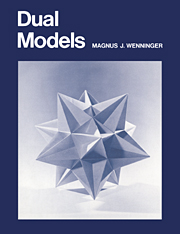Book contents
- Frontmatter
- Contents
- Foreword by John Skilling
- Preface
- Introduction
- I The five regular convex polyhedra and their duals
- II The thirteen semiregular convex polyhedra and their duals
- III Stellated forms of convex duals
- IV The duals of nonconvex uniform polyhedra
- V Some interesting polyhedral compounds
- Epilogue
- Appendix: Numerical data
- References
- List of polyhedra and dual models
- Frontmatter
- Contents
- Foreword by John Skilling
- Preface
- Introduction
- I The five regular convex polyhedra and their duals
- II The thirteen semiregular convex polyhedra and their duals
- III Stellated forms of convex duals
- IV The duals of nonconvex uniform polyhedra
- V Some interesting polyhedral compounds
- Epilogue
- Appendix: Numerical data
- References
- List of polyhedra and dual models
Summary
The stellation process was described in some detail in Polyhedron models; so I shall simply refer you to that source for more detailed information. But I must say at once that a thorough acquaintance with this process is really a necessity if you want to acquire a deeper appreciation of its usefulness in relation to polyhedral duality. This will become very evident as you work your way through the models presented here.
Basic notions about stellation and duality
Very little has been published about stellations of Archimedean solids. My own work has led me to see that there is no reason to limit oneself to strictly Archimedean forms. In fact, some variations lead to far more aesthetically pleasing results, and such variations become necessary, unavoidably so, in the process of working out some of the dual forms of nonconvex uniform polyhedra. Interesting as the stellation process may be in its own way, it will not be the primary concern here.
As for duality, it seems strange in some ways that historically its geometrical significance was not clearly recognized until modern times. The five regular solids were known in ancient times, as was the entire set of thirteen semiregular solids. Johannes Kepler, in 1611, seems to have been the first to have recognized that the rhombic dodecahedron is the dual of the cuboctahedron. Other duals seem not to have entered into historical perspective until the work of E. Catalan, a French mathematician, who published his results in 1862.
- Type
- Chapter
- Information
- Dual Models , pp. 1 - 6Publisher: Cambridge University PressPrint publication year: 1983



